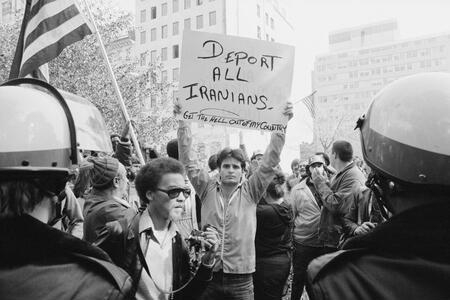 Student Demonstration during Iran Hostage Crisis, Washington, D.C., USA, photograph by Marion S. Trikosko, November 9, 1979. |
Comparing the two situations shows how much has changed in the last four decades – none of it for the better.
Hostages, Then and Now
The Americans taken hostage by Khomeini's followers were all adults working at the U.S. embassy. The captives in Gaza today, both male and female, range from infants to the aged. One hostage, Kfir Bibas, born on January 18, 2023, was only 262 days old when he was stolen from his bed. He celebrated his first birthday as a hostage and has spent the majority of his life as a Hamas prisoner.
Some of the American diplomats were beaten during and after the November 4 siege of the U.S. embassy. They were undoubtedly held in inhumane conditions and sometimes threatened with execution. But unlike those seized on October 7, not one was executed. Not a single one was raped.
After the first few days of their captivity, unless they were being moved from one location to another or paraded in the street, the American diplomats were not blindfolded. Aside from when they were kept periodically in a damp, windowless warehouse on the embassy grounds, which the hostages named "The Mushroom Inn," they could see outside. Hamas's hostages, on the other hand, have likely been kept underground in the maze of tunnels that constitute subterranean Gaza for most of their 444 days of captivity. Many have likely not seen the sun in all that time. They have been severely beaten.
On November 17, 1979, Khomeini ordered the female and African-American hostages released because "Islam has a special respect toward women" and because blacks had been forced to suffer "under American pressure and tyranny." The women released by Hamas in the November 2023 ceasefire were sexually assaulted and constantly intimidated.
Those Americans held by Iran who were injured or ill received medical care, albeit inferior to what they deserved. One hostage, Richard Queen, the State Department's Vice Consul, suffering the early stages of undiagnosed multiple sclerosis, was released after 250 days. His symptoms baffled the Iranian physicians who treated him, and his captors feared the consequences of his dying in captivity. Hamas has no such fears.
UN Responses, Then and Now
In 1979, the United Nations was not quite as corrupted as it is today. The Security Council responded if not quickly (on December 4) at least decisively with Resolution 457 calling for the immediate release of the hostages. On December 31, it issued Resolution 461, condemning Iran and citing an International Court of Justice order for the release of all hostages.
In 2023, after weeks of failing to reach a consensus, the Security Council finally issued Resolution 2712 on November 15, calling for the release of all hostages, but it did not condemn or even mention the October 7 attack.
Today's U.N. is focused on condemning Israel. It has whitewashed the complicity of the Palestinian people in October 7 and exaggerated their suffering. The Secretary General's statement was one half condemnation of Hamas and one-half warning that Israel exercise "maximum restraint" and pursue a "two-state solution." The International Court of Justice took South Africa's charges of genocide seriously and opened an investigation into Israeli conduct, and the International Criminal Court issued arrest warrants for Israeli Prime Minister Benjamin Netanyahu and Defense Minister Yoav Gallant.
Media Coverage
In 1979, the media at first repeated the false narrative that the hostage takers were merely religious students, not Khomeini's agents carrying out his will. But as one hostage, Barry Rosen, put it, "Khomeini was supporting our captivity; it was not just these students acting in his name." Rosen adds that, "the students couldn't have continued to hold us without the Imam's approval."
Throughout the 444-day ordeal, the media focused on the hostages, their families, and efforts being made to free them. On ABC, Ted Koppel's career was made by a show called The Iran Crisis: America Held Hostage, which eventually became Nightline.
By contrast, today's media have not made the hostages the focal point of the story. Rather than seeing the hostages as victims of Islamist aggression, much of today's media are more sympathetic with Palestinians and Hamas than with their hostages. They focus on "Israel's War in Gaza," celebrate anti-Israel protests, and mindlessly repeat Hamas's inflated casualty and death statistics.
When Israel killed Ismail Haniyeh, the media harped on how much more difficult a "hostage deal" would be and accused Israeli PM Benjamin Netanyahu of belligerence.
When Israel decimated (or more) the leadership of Hezbollah – another terrorist organization responsible for holding Americans hostage – in a brilliant pager/walkie-talkie sabotage like something out of a James Bond movie, much of the media vilified it as terrorism. But then again, so did many leftists from the unknown all the way up to former CIA Director, Secretary of Defense and longtime California Democrat, Leon Panetta.
Like the U.N., the media have whitewashed the complicity of the Palestinian people on October 7 and exaggerated their suffering. It was obvious that the October 7 marauders, rapists, and hostage-takers were a combination of trained Hamas Einsatzgruppen commandos and regular Gazan "civilians," yet the media would rarely acknowledge the role of common Gazans in the attack, even in the face of the evidence those Gazans posted on their social media. Outside of Israel, the father and son duo who acknowledge matter-of-factly to their interrogators that they took turns raping a young woman before killing her was woefully underreported.
One of the greatest differences between the coverage of the hostages held in Iran 45 years ago and of the hostages in Gaza today is that no one was on Iran's side then, while many are on Hamas's side today.
Academia Reacts
For Americans, and indeed for much of the Western world, the seizure of our diplomats in 1979 was an affront too outrageous to endure. People were angry at the Iranians, Khomeini, and Jimmy Carter. In the days before memes, Americans adopted a line from a popular song by Tony Orlando and Dawn ("Tie a Yellow Ribbon Round the Ole Oak Tree"). Yellow ribbons appeared around trees throughout the nation as symbols of their suffering and the American people longing for their return.
Most American academics were as outraged as everyone else in 1979, and all but the most virulently anti-American among them who weren't outraged likely kept it to themselves. By contrast, today's academics are more likely to celebrate October 7, especially Middle East studies "experts."
College students were firmly on the side of the U.S.A. in 1979. If there were any protests, they were anti-Iran protests. As a freshman at the University of Miami in November of 1979, I saw many cars sporting the famous bumper sticker, and people wearing the t-shirt, featuring Mickey Mouse holding an American flag in his right hand while giving the middle-finger salute with his left hand with the caption "Hey Iran."
By contrast, today's college students are more likely to wear keffiyehs and chant "From the River to the Sea" or "Globalize the Intifada" and other slogans they don't understand.
End of the Crises
The 52 Americans held in Iran were released only after one-term president Jimmy Carter left the White House and Ronald Reagan was inaugurated. Reagan called Khomeini and his henchmen "criminals and thugs" and promised a very different approach than the weak coddling that the Carter administration had pursued. His approach succeeded.
When the hostages were finally released, there was a ticker-tape parade in their honor as they were celebrated in New York City's "Canyon of Heroes."
Will the hostages in Gaza have to wait until one-term president Joe Biden leaves the White House and Donald Trump is inaugurated? That will make it 472 days in captivity. Will there be a ticker-tape parade?
President-elect Donald Trump has pledged to get the hostages back and threatened that "there will be hell to pay" if they are not returned by his January 20th inauguration. It will be a well-deserved hell.
 Chief IPT Political Correspondent A.J. Caschetta is a principal lecturer at the Rochester Institute of Technology and a fellow at Campus Watch, a project of the Middle East Forum where he is also a Milstein fellow.
Chief IPT Political Correspondent A.J. Caschetta is a principal lecturer at the Rochester Institute of Technology and a fellow at Campus Watch, a project of the Middle East Forum where he is also a Milstein fellow.
Copyright © 2024. Investigative Project on Terrorism. All rights reserved.
